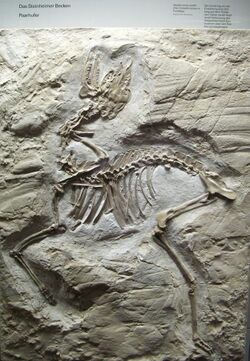Biology:Euprox
| Euprox Temporal range: Mid - Late Miocene
| |
|---|---|

| |
| Fossil of Euprox sp.. | |
| Scientific classification | |
| Domain: | Eukaryota |
| Kingdom: | Animalia |
| Phylum: | Chordata |
| Class: | Mammalia |
| Order: | Artiodactyla |
| Family: | Cervidae |
| Genus: | †Euprox Stehlin, 1928 |
| Type species | |
| †Euprox furcatus Hensel, 1859 (As Prox furcatus)
| |
| Species[1] | |
| |
| Synonyms | |
|
Prox | |
Euprox is an extinct genus of deer that lived in Eurasia during the Miocene.
Taxonomy
The type species Euprox furcatus was originally under the genus Prox, but that name was already taken. Depéret assigned it to the related genus Dicrocerus in 1887, before it was assigned to its current placement in 1928.[2] Euprox dicranocerus and Euprox minimus were transferred to the genus soon after; they were originally described as Cervus dicranocerus and Dicracerus minimus, respectively.[3]
Description
Euprox was some of the earliest types of deer known to have true antlers.[4] It would have resembled a muntjac in size and appearance, standing at up to 1 m (3.3 ft) in height.
The antlers of Euprox were short, with two small prongs projecting from the main branch. Euprox is notable for being the earliest deer to possess the presence of a real burr, which are indicative of the border between permanent and deciduous segments of deer antlers.[5] It possessed brachyodont teeth and likely fed on leaves.[4] The environment that Euprox inhabited would have been warm and humid, with many tropical forests.[4][6]
References
- ↑ "Euprox". https://www.biolib.cz/en/taxon/id1196833/.
- ↑ Głazek, J. (1971). "Miocene vertebrate faunas from Przeworno (Lower Silesia) and their geological setting". Acta Geologica Polonica 21 (3). https://geojournals.pgi.gov.pl/agp/article/view/10155.
- ↑ Hou, S. (2014). "A new species of Euprox (Cervidae, Artiodactyla) from the upper Miocene of the Linxia Basin, Gansu Province, China, with interpretation of its paleoenvironment". Zootaxa 3911 (1): 43–62. doi:10.11646/zootaxa.3911.1.2. PMID 25661595. https://www.researchgate.net/publication/271519119.
- ↑ 4.0 4.1 4.2 Dong, W.; Liu, J.; Pan, Y. (003). "A new Euprox from the Late Miocene of Yuanmou, Yunnan Province, China, with interpretation of its paleoenvironment". Chinese Science Bulletin 48 (5): 485–491. doi:10.1007/BF03183257. Bibcode: 2003ChSBu..48..485D. http://doc.rero.ch/record/15711/files/PAL_E3062.pdf.
- ↑ Agustí, Jordi; Antón, Mauricio (2002). Mammoths, Sabertooths, and Hominids: 65 Million Years of Mammalian Evolution in Europe. Columbia University Press. p. 141. ISBN 9780231116411.
- ↑ "New cervid species found in middle miocene of Nei Mongol, China". Institute of Vertebrae Paleontology and Paleoanthropology. https://phys.org/news/2011-11-cervid-species-middle-miocene-nei.html.
Wikidata ☰ Q3734596 entry


